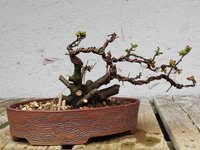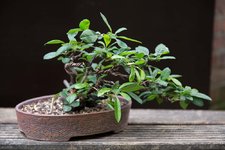You are using an out of date browser. It may not display this or other websites correctly.
You should upgrade or use an alternative browser.
You should upgrade or use an alternative browser.
Chaenomelis - Chinese quince
- Thread starter leatherback
- Start date
leatherback
The Treedeemer
leatherback
The Treedeemer
BonsaiDTLA
Shohin
I believe this is the Japanese Flowering Quince and not the Chinese Quince, Pseudocydonia sinensis
leatherback
The Treedeemer
You are right.I believe this is the Japanese Flowering Quince and not the Chinese Quince, Pseudocydonia sinensis
Maybe @sorce can change the thread title?
River's Edge
Masterpiece
With Quince the usual practice is to wire the new shoots for form, usually 7-10 cm at a time. The rest is usually cut back and therefore not wired out to the tip during the growing season. I would expect mature branches to take a year or two to set form. And if wiring more mature branches would use a two wire approach to reduce breakage and the tendency to cut in too deep while waiting for the branch to set. The two wire approach refers to same size spaced a bit apart to provide additional support when bending. Some times the double wire is wrapped beside each other, not in this instance.I grew a quince in my growing beds for a few years, cutting back every year. In winter I lifted it, potted it up and wired the branches in place. I was wondering.. Anybody have experience with this species? How long do mature branches take to set in place?
View attachment 335149
leatherback
The Treedeemer
Really? So I need to revert to @Bonsai Nut ?My powers, like the clothes of young lovers, or paint on an old car, or leaves in a typhoon, like the jacket off wire to be annealed for use, have been stripped!
Sorce
Clicio
Masterpiece
I have the same doubt as @leatherback .
If I don't wire, straight sticks; if I wire and let the wires on till the branches harden, the wires bite.
Perhaps @River's Edge technique will solve this problem, thanks Fred!
If I don't wire, straight sticks; if I wire and let the wires on till the branches harden, the wires bite.
Perhaps @River's Edge technique will solve this problem, thanks Fred!
River's Edge
Masterpiece
Who's Fred!I have the same doubt as @leatherback .
If I don't wire, straight sticks; if I wire and let the wires on till the branches harden, the wires bite.
Perhaps @River's Edge technique will solve this problem, thanks Fred!
Always better to wire early with species that tend to be brittle! Using raffia or similar wrap, spacing the wire are all techniques used to deal with the more difficult bends to protect against breakage and damage to the bark. The spaced wire technique provides twice as many support points for bending over the same distance!
I still break a few, but fewer than before!
leatherback
The Treedeemer
I am normally a fan of baby banding. It is just.. This thick base had branches. And in the filed I did not wire. I just clipped out the big branches every once in a while. I did not want to cut back to a stump. Over summer I wired the young shoots in place. THose will have set, no concerns!If I don't wire, straight sticks; if I wire and let the wires on till the branches harden, the wires bite.
Clicio
Masterpiece
Clicio
Masterpiece
Over summer I wired the young shoots in place. THose will have set, no concerns!
So I will wait to wire them in the summer, now they are still very tender and droopy by it's own weight.
I guess I will try the double wiring as suggested by @River's Edge .
leatherback
The Treedeemer
Only if they are woody. If you do it when still green and starting to mature a 1mm alu will do the job.I guess I will try the double wiring as suggested by @River's Edge .
Clicio
Masterpiece
Exactly, the old straight ones get double wiring, the new growth get a little bending near the bottom of the not so woody branches.Only if they are woody. If you do it when still green and starting to mature a 1mm alu will do the job.
Wires_Guy_wires
Imperial Masterpiece
@bonhe uses a soft-bending technique that I use in softer plants as well.
Squeeze the branches while they're still green and make sure you damage (but not destroy!) the tissue. Then wiggle at the pinch position; if your thumb and index finger are at the top and the bottom, move up or down. If they were on the sides, you can do left/right movement. This allows the crushed tissue to flex way more since plant tissue is organized in stacked layers (like some electrical wires) and squeezing/crushing those will break the tension and prevent snapping, and if done right there's hardly any scarring after two seasons. No need for wire, because they'll heal in the way they are oriented.
Think of it like a pack of dry spaghetti: If you bundle them and bend them, they'll snap. If you lay every string next to one another, they flex way more. If you wet them at the bending point and let them dry over night, they'll stay in place.
My chaenomeles japonica are still in their infant stages from seed, or year-old cuttings from parking lot ones.. But it seems like this bending technique could work.
I'll give it a shot tomorrow and let you guys know how the tissue responds, not every plant takes this technique well.
Squeeze the branches while they're still green and make sure you damage (but not destroy!) the tissue. Then wiggle at the pinch position; if your thumb and index finger are at the top and the bottom, move up or down. If they were on the sides, you can do left/right movement. This allows the crushed tissue to flex way more since plant tissue is organized in stacked layers (like some electrical wires) and squeezing/crushing those will break the tension and prevent snapping, and if done right there's hardly any scarring after two seasons. No need for wire, because they'll heal in the way they are oriented.
Think of it like a pack of dry spaghetti: If you bundle them and bend them, they'll snap. If you lay every string next to one another, they flex way more. If you wet them at the bending point and let them dry over night, they'll stay in place.
My chaenomeles japonica are still in their infant stages from seed, or year-old cuttings from parking lot ones.. But it seems like this bending technique could work.
I'll give it a shot tomorrow and let you guys know how the tissue responds, not every plant takes this technique well.
Paulpash
Masterpiece
Here's how I handle them. In Spring remove the first pair of leaves on the stem. They will remain budless if left in tact. Allow green stems to extend 8-10 nodes then cut back to 2-3. Wire when shoots are still green - you should be able to get a wiggle in. Only by building up lots of vigour will you get more than 1 bud to grow in to a shoot after extension growth cut back. Keep an eye on wire but it should set in 6 weeks. Here's mine last year. I should have taken a pic of it today - I cut back the long growth after I was sure it had finished for the year. The top third of the centre trunk is a lot fuller now. One other thing is that hard cut back into old wood in Winter causes a lot of dormant buds to waken if it has grown vigorously all season - more so than with regular pruning during the growing season. 

bonhe
Masterpiece
Thanks for pulling me up to this discussion@bonhe uses a soft-bending technique that I use in softer plants as well.
Squeeze the branches while they're still green and make sure you damage (but not destroy!) the tissue. Then wiggle at the pinch position; if your thumb and index finger are at the top and the bottom, move up or down. If they were on the sides, you can do left/right movement. This allows the crushed tissue to flex way more since plant tissue is organized in stacked layers (like some electrical wires) and squeezing/crushing those will break the tension and prevent snapping, and if done right there's hardly any scarring after two seasons. No need for wire, because they'll heal in the way they are oriented.
Think of it like a pack of dry spaghetti: If you bundle them and bend them, they'll snap. If you lay every string next to one another, they flex way more. If you wet them at the bending point and let them dry over night, they'll stay in place.
My chaenomeles japonica are still in their infant stages from seed, or year-old cuttings from parking lot ones.. But it seems like this bending technique could work.
I'll give it a shot tomorrow and let you guys know how the tissue responds, not every plant takes this technique well.
Yes, I have been using this technique for a while on pomegranate, quince. It is very effective. I even made a soft break on these specimens . This quince was taken picture 2 weeks ago
It had a straight branch which went upward (in red circle)
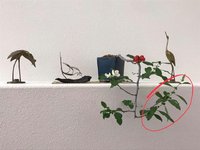
I made a soft break on this branch. It took me about 2 seconds to do! The yellow arrow is pointed to the broken site . The branch is going downward now
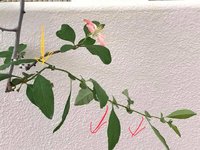
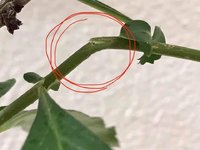
It is just now . Healing well.


Thụ Thoại
River's Edge
Masterpiece
Interesting, how well does the technique work for upward or sideways movement. Any additional steps required?Thanks for pulling me up to this discussion
Yes, I have been using this technique for a while on pomegranate, quince. It is very effective. I even made a soft break on these specimens . This quince was taken picture 2 weeks ago
It had a straight branch which went upward (in red circle)
View attachment 335356
I made a soft break on this branch. It took me about 2 seconds to do! The yellow arrow is pointed to the broken site . The branch is going downward now
View attachment 335357
View attachment 335358
It is just now . Healing well.
View attachment 335355
View attachment 335354
Thụ Thoại
Does the area where the soft break is created eventually return to normal appearance or appear damaged?
bonhe
Masterpiece
Thanks for asking. I don’t do upward or sideway movements, so I can not answer !Interesting, how well does the technique work for upward or sideways movement. Any additional steps required?
Does the area where the soft break is created eventually return to normal appearance or appear damaged?
No additional step!
With pomegranate, it tends to spring back to original status but much less. In this case, I just reapply the technique
If it is broken with the hardwood coming out (like open fracture on the human with the bone coming out from the wound ), it will stay like that forever if we’d don’t cut off the part of the hardwood exposed to the outside. Otherwise, the area will be healed well. These areas had soft breaking technique a few years ago.

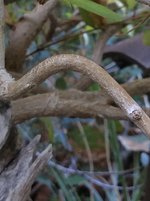
Thụ Thoại
Similar threads
- Replies
- 5
- Views
- 187
- Replies
- 1
- Views
- 174


